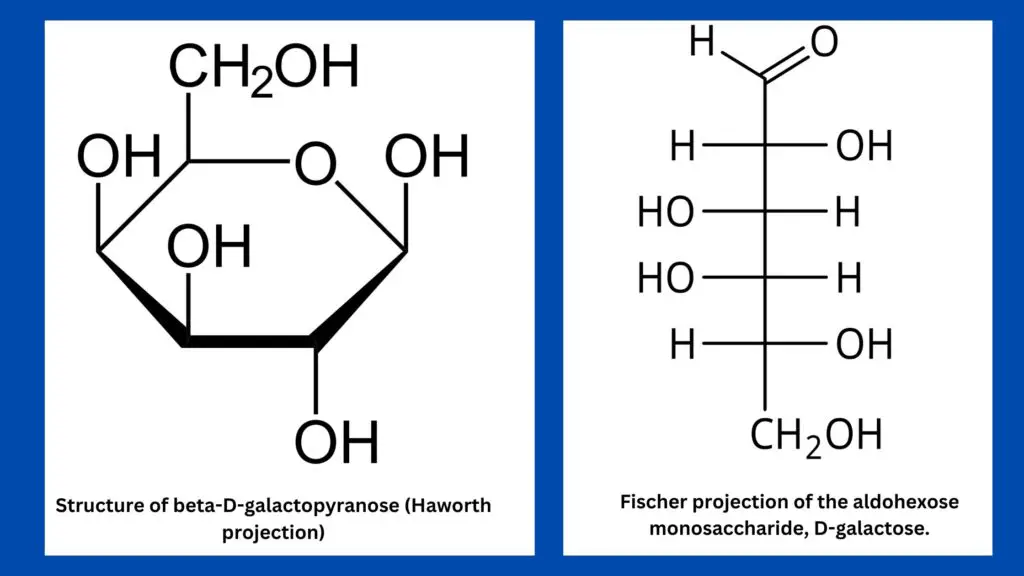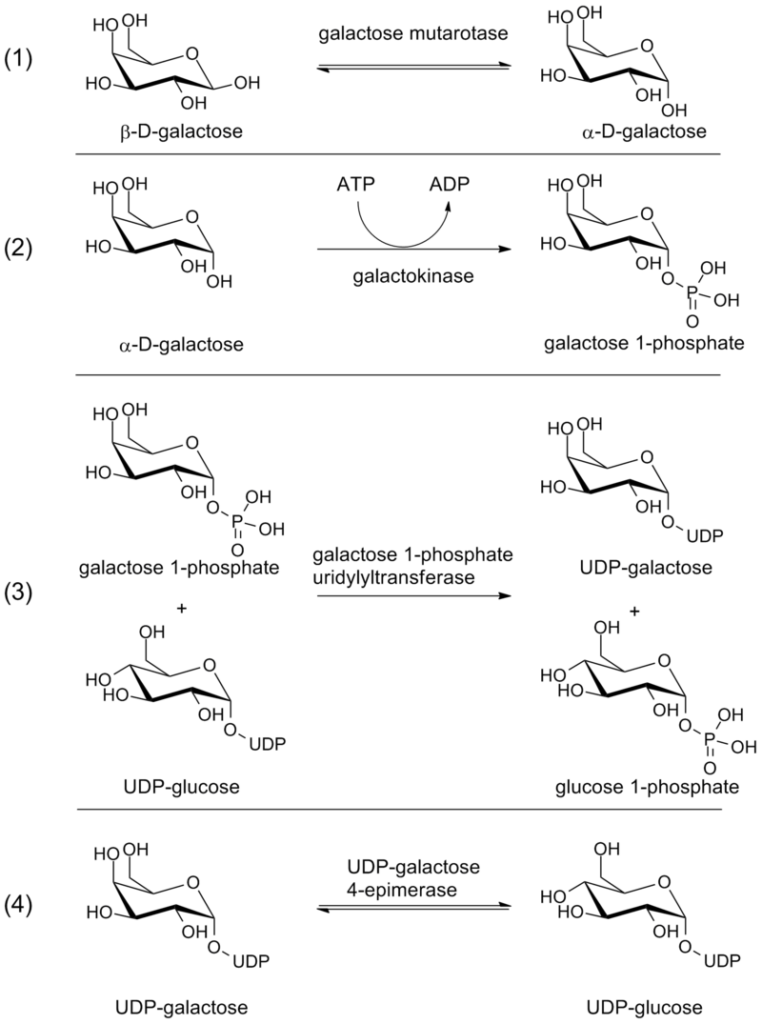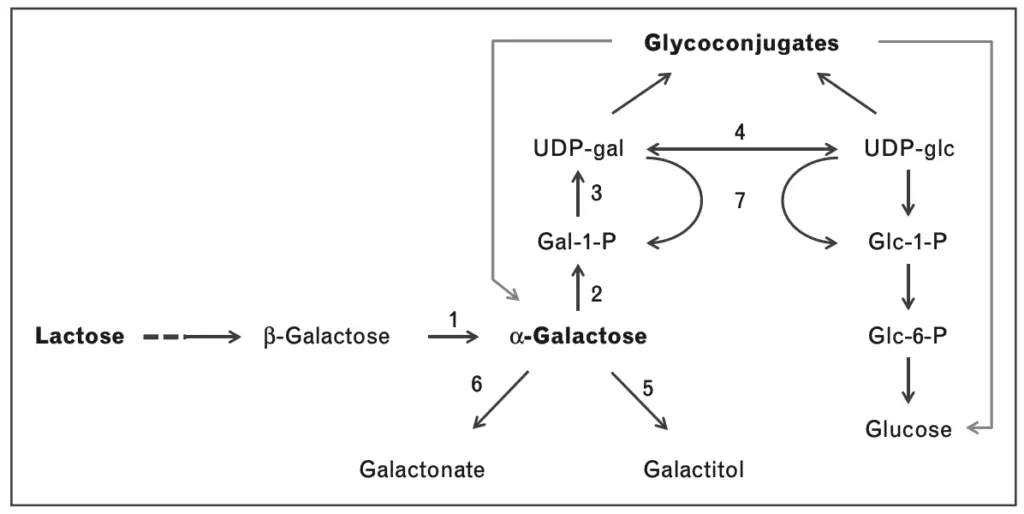What is Galactose?
Galactose is a monosaccharide sugar that is an aldohexose. It is a C-4 epimer of glucose having the same structure as glucose, except that the atoms around carbon no. 4 are arranged differently. This sugar is around 65% of the sweetness of sucrose and is less sweet. It is paired with glucose to form lactose, the main sugar present in milk.
Like many monosaccharides, galactose naturally exists as a polymer, called galactan, which is an important structural component of hemicellulose. Galactans are important in many biological processes, especially in plants, where they are able to make either carbohydrate storage or cell wall.
D-Galactose is known as “brain sugar” because it is involved in glycoprotein formation. They hold vital roles in nerve tissue where they take part in a range of cellular functions like cell signaling and molecular recognition. This significance highlights galactose’s role in human physiology.
Galactose derives its name from the Greek “galaktos,” milk, in combination with the chemical suffix “-ose,” which indicates sugars. The etymology is similar to that of “lactose,” a disaccharide of galactose and glucose. Both terms carry the connotation with milk of these sugars, as well as their biochemical functions in energy and structural processes.
What is Galactose Metabolism?
- Galactose metabolism is a types of biochemical process by which galactose monosaccharide, which is primarily obtained from lactose in dairy products, is converted into glucose-6-phosphate. This process occurs inside the cytoplasm of liver cells. It’s helps galactose to be integrated into glycolysis and can be used for energy production or other cellular processes.
- The hydrolyzed lactose releases galactose and glucose. Next, glucose directly enters glycolysis, galactose requires a multi-step pathway called the galactose-glucose interconversion pathway. This process made of four enzymatic steps, such as phosphorylation, epimerization, and transfer reactions, to modify galactose into a form that matches the metabolic requirements of the glycolytic pathway.
- In the initial step, galactose is phosphorylated by galactokinase, forming galactose-1-phosphate. Then, through the action of galactose-1-phosphate uridylyltransferase, this intermediate is exchanged with UDP-glucose to produce UDP-galactose and glucose-1-phosphate. UDP-galactose is subsequently converted to UDP-glucose by UDP-galactose-4-epimerase, completing the interconversion. The glucose-1-phosphate generated in this process is finally isomerized into glucose-6-phosphate by phosphoglucomutase, readying it for glycolysis.
- This pathway not only integrates galactose into energy metabolism but also supports the synthesis of biomolecules such as glycoproteins and glycolipids, essential for cellular functions. Disruptions in this metabolic process, such as enzymatic deficiencies, can lead to disorders like galactosemia, which affects the body’s ability to process galactose efficiently. Understanding galactose metabolism is crucial for grasping its role in energy production and broader biochemical pathways.
Where does Galactose Metabolism take Place?
- Galactose metabolism occurs predominantly in the cytoplasm of liver cells. The liver serves as the central site for processing galactose after it enters the body through dietary sources, particularly lactose-containing foods. Once absorbed in the intestines, galactose is transported via the portal vein to the liver for further biochemical conversion.
- Within the liver, galactose undergoes enzymatic reactions, collectively known as the galactose-glucose interconversion pathway. This pathway transforms galactose into glucose-6-phosphate, a metabolically active intermediate used for energy production or glycogen synthesis. While the liver is the primary site for galactose metabolism, other tissues such as the kidneys and intestines also contribute to its processing, albeit to a lesser extent.
- This localized metabolism ensures that galactose is efficiently integrated into broader energy and biosynthetic pathways, maintaining homeostasis and supporting essential cellular functions.
Structure and Isomerism of Galactose
Galactose exists in both an open-chain and a cyclic form. It is a monosaccharide with distinct structural properties and isomeric forms that play important roles in biological processes.

- Open-Chain Form
- The open-chain form of galactose has a carbonyl group at the end of the chain.
- This structure is less stable than the cyclic form and can interconvert between different isomers.
- Cyclic Forms
- Galactose can cyclize to form two types of rings: pyranose (six-membered ring) and furanose (five-membered ring).
- Four isomers of galactose are cyclic: two with a pyranose ring and two with a furanose ring.
- Galactofuranose
- The furanose form, known as galactofuranose, is found in bacteria, fungi, and protozoa.
- It is recognized by the intelectin lectin in chordates due to its unique exocyclic 1,2-diol structure.
- Anomerism
- In the cyclic form, galactose exhibits anomerism, where two distinct forms—alpha and beta—exist.
- The transition from the open-chain to the cyclic form generates a new stereocenter at the site of the original carbonyl group, leading to these anomers.
- Spectroscopic Properties
- IR Spectroscopy: The IR spectra of galactose shows a broad, strong stretch between wavenumbers 2500 cm−1 to 3700 cm−1, which is characteristic of hydroxyl (OH) groups.
- Proton NMR Spectroscopy:
- Peaks in the proton NMR spectra of galactose appear at 4.7 ppm (D2O), 4.15 ppm (−CH2OH), and several signals around 3.75, 3.61, 3.48, 3.20 ppm (−CH2 of the ring).
- The spectrum also includes a broad region between 2.79–1.90 ppm for the hydroxyl groups (−OH).


Galactose Metabolism Steps
Galactose metabolism is a series of enzymatic reactions that convert galactose into glucose-6-phosphate, allowing the sugar to enter energy-producing pathways like glycolysis or be stored as glycogen.
- Step 1: Phosphorylation
- Enzyme: Galactokinase (GALK)
- Reaction: Galactose + ATP → Galactose-1-phosphate + ADP
- In this initial step, galactose is phosphorylated by galactokinase to form galactose-1-phosphate. This process requires ATP, which is converted to ADP.
- Step 2: Conversion to UDP-Galactose
- Enzyme: Galactose-1-phosphate uridylyltransferase (GALT)
- Reaction: Galactose-1-phosphate + UTP → UDP-galactose + PPi
- Galactose-1-phosphate undergoes a transfer of a uridine monophosphate group from UTP to form UDP-galactose. This step produces pyrophosphate (PPi) as a byproduct.
- Step 3: Epimerization
- Enzyme: UDP-galactose 4-epimerase (GALE)
- Reaction: UDP-galactose → UDP-glucose
- UDP-galactose is converted to UDP-glucose via epimerization. This change in configuration prepares the molecule for further metabolism in pathways such as glycolysis.
- Step 4: Conversion to Glucose-6-Phosphate
- Enzyme: Phosphoglucomutase
- Reaction: Glucose-1-phosphate → Glucose-6-phosphate
- The glucose-1-phosphate produced from galactose is isomerized into glucose-6-phosphate. This compound can now enter glycolysis to produce energy or be stored as glycogen.

The Leloir Pathway
The Leloir pathway is the primary mechanism by which the body metabolizes galactose, an important monosaccharide. This pathway converts galactose into glucose, making it essential for energy production and glycogen synthesis.

- Galactose Conformations
- Galactose is found in two predominant forms in aqueous solutions: the α– and β-pyranose structures.
- These forms differ in the configuration of the hydroxyl group at carbon-1 of the ring.
- Upon release from lactose, galactose exists in its β-conformation.
- Galactose mutarotase (GALM) catalyzes the conversion of β-galactose into the α-anomer.
- Galactose Mutarotase (GALM)
- GALM is an aldose 1-epimerase, which facilitates the interconversion between α and β-hexose sugars.
- The conversion of β-galactose to α-galactose is a critical step for entering the Leloir pathway.
- Step-by-Step Metabolism of α-Galactose
- Once in the α-form, galactose is processed by three key enzymes:
- Galactokinase (GALK):
- Converts α-galactose into galactose-1-phosphate (Gal-1-P).
- GALK is part of the GHMP kinase family and uses ATP as a cofactor for phosphorylation.
- The reaction involves the formation of a ternary complex with ATP binding first, followed by galactose.
- Gal-1-P is a feedback inhibitor of GALK, preventing over-accumulation of the product.
- Galactose-1-phosphate uridylyltransferase (GALT):
- Transfers the uridine group from UDP-glucose to Gal-1-P, producing glucose-1-phosphate (Glc-1-P) and UDP-galactose (UDP-gal).
- GALT operates through a ping-pong mechanism, with covalent binding to a histidine residue (His186).
- This allows the enzyme to shift between different substrates and catalyze the transfer of the uridine group.
- UDP-galactose 4’-epimerase (GALE):
- This enzyme interconverts UDP-gal and UDP-glucose.
- GALE is part of the short-chain dehydrogenases/reductases family and requires NAD+ as a cofactor for its function.
- It facilitates the oxidation and reduction of the sugar moiety, inverting its configuration at carbon-4.
- Galactokinase (GALK):
- Once in the α-form, galactose is processed by three key enzymes:
- Outcome of the Leloir Pathway
- The final result of the Leloir pathway is the production of Glc-1-P and UDP-gal.
- Glc-1-P can be further converted into glucose-6-phosphate for energy release.
- UDP-gal is crucial for glycosylation reactions, serving as the galactose donor in these processes.
- Physiological Role
- The Leloir pathway allows for the rapid conversion of galactose into glucose, making it an efficient process for the body to use galactose as an energy source.
- After an oral or intravenous galactose load, the glucose levels in the blood increase by 50% within 30 minutes.
- Unlike glucose and fructose, galactose is primarily directed toward liver glycogen synthesis, rather than undergoing oxidation.
- Galactose Metabolism in the Liver
- The liver is the main organ responsible for processing galactose, although the enzymes of the Leloir pathway are also found in other tissues.
- The liver plays a central role in efficiently metabolizing galactose, making it a key player in maintaining glucose homeostasis.

Accessory Pathways of Galactose Metabolism
While the Leloir pathway is the primary route for galactose metabolism, alternative pathways also play crucial roles in processing galactose. These accessory pathways help manage galactose in different contexts and can lead to the formation of metabolites that are either excreted or further processed in other metabolic routes.
- Galactose Reduction
- Aldose reductase (EC 1.1.1.21) catalyzes the reduction of galactose to galactitol.
- Galactitol is not further metabolized in the body and accumulates in tissues.
- Due to its poor diffusivity, galactitol can accumulate in cells, which can be harmful in conditions like galactosemia.
- Galactose Oxidation
- The enzyme galactose dehydrogenase (EC 1.1.1.48) catalyzes the oxidation of galactose to form galactonate.
- Galactonate can be excreted directly in the urine.
- Alternatively, it can be further metabolized through the pentose phosphate pathway, a key pathway for cellular metabolism and nucleotide synthesis.
- Pyrophosphorylase Pathway
- In this pathway, UDP-glucose/galactose pyrophosphorylase (UGP, EC 2.7.7.10) works alongside GALK and GALE to convert galactose into UDP-glucose.
- This pathway provides a means for the body to generate UDP-glucose from galactose, supporting various glycosylation reactions.
Biological Importance of the Leloir Pathway
The Leloir pathway plays a crucial role in the metabolism of galactose, which is essential for various developmental processes. This pathway is conserved across multiple organisms, highlighting its biological significance.
- Developmental Relevance
- In humans, the activities of enzymes like GALK and GALT are detectable in fetal tissue by the 10th week of pregnancy. Their activities increase with gestational age, reaching peak levels at birth before gradually decreasing postnatally.
- In rats, the developmental modulation of the Leloir enzymes has been extensively studied. Enzymes like GALK, GALT, and GALE show specific developmental patterns. While GALK remains relatively constant, GALT and GALE increase during fetal development and stabilize around birth.
- During the suckling period, when galactose is essential for development, the young liver exhibits higher enzyme activities to efficiently metabolize galactose.
- Role in Glycosylation
- The Leloir pathway generates UDP-galactose, which acts as the galactose donor in glycosylation reactions. These reactions are vital for the synthesis of complex glycoconjugates, which are required for numerous cellular processes, including growth, differentiation, and morphogenesis.
- UDP-galactose is produced in the cytoplasm and is transported to the endoplasmic reticulum and Golgi apparatus, where it is used by glycosyltransferases for glycosylation.
- The third enzyme in the Leloir pathway, GALE, interconverts UDP-galactose with UDP-glucose, helping maintain the balance of these key substrates required for cellular processes.
- Myelinogenesis and Brain Function
- The Leloir pathway is particularly important in the production of galactocerebrosides, the predominant glycolipid in myelin. Galactose was historically referred to as cerebrose, reflecting its significance in brain function.
- Research has shown that GALT expression peaks in oligodendrocytes and Schwann cells during myelination, which correlates with the production of galactocerebrosides needed for the formation of myelin.
- Endogenous Galactose Synthesis
- The human body can synthesize de novo galactose, a process first described by Gitzelmann. This synthesis primarily occurs through the Golgi-dependent turnover of galactose-containing macromolecules, such as glycoproteins and glycolipids.
- Endogenous galactose production is particularly high in infants and young children, supporting the rapid growth and development during these early years. It is suggested that fetal tissues may produce even higher levels of galactose before birth, further emphasizing its importance for early development.
The Leloir pathway’s contribution goes beyond just energy production. It is a cornerstone of glycosylation and cellular development, impacting critical processes like myelinogenesis and the growth of the nervous system.
The enzymes involved in the Leloir pathway play critical roles in the metabolism of galactose. However, their activity is regulated to ensure efficient processing of galactose, balancing metabolic needs and maintaining cellular homeostasis.
- GALK as a Rate-Limiting Enzyme
- GALK (Galactokinase) is considered the rate-limiting enzyme in the Leloir pathway.
- After galactose enters the cell, GALK rapidly phosphorylates it, effectively trapping the sugar inside the cell.
- This phosphorylation is key for initiating galactose metabolism, but the removal of galactose from the blood becomes saturated at a concentration of 50 mg/dl.
- The limited ability of GALK to phosphorylate galactose at higher concentrations contributes to this saturation.
- GALE’s Role and Regulation
- Despite GALK being thought to be the primary rate-limiting enzyme, studies indicate that GALE (UDP-galactose-4-epimerase) might play a more significant role in regulating the pathway.
- GALE has the lowest specific activity among the Leloir enzymes, suggesting its function is critical in maintaining the proper ratios of nucleotide sugars.
- GALE helps regulate the balance of UDP-galactose and UDP-glucose, crucial for proper cellular functioning, particularly in glycosylation processes.
- Enzyme Activity and Cellular Function
- The activities of these enzymes are tightly controlled, as they directly influence the levels of UDP-galactose, a key donor for glycosylation reactions.
- Given its involvement in glycosylation, the regulation of GALE is vital for maintaining proper cellular processes like growth, differentiation, and development.
Results of Galactose Metabolism
The metabolism of galactose leads to the formation of energy, metabolic intermediates, and essential biomolecules. These outcomes support critical physiological functions and biochemical processes.
- Conversion to Glucose
- Galactose enters the Leloir pathway and is converted to glucose-1-phosphate.
- Glucose-1-phosphate is further transformed into glucose-6-phosphate, which feeds into glycolysis for ATP production.
- Production of Metabolic Intermediates
- UDP-galactose is a key intermediate formed during this process.
- This compound is crucial for glycosylation, a process used to synthesize glycoproteins and glycolipids.
- Energy Yield
- The metabolism of galactose provides substantial energy in the form of ATP.
- This energy production is particularly vital in energy-intensive tissues like the brain and muscles.
- Integration into Other Pathways
- Metabolites derived from galactose are used in pathways for synthesizing nucleotides and other biomolecules.
- This integration highlights the interconnected nature of galactose metabolism with broader cellular functions.
- Role in Lactation
- In lactating women, galactose is used with glucose to produce lactose for milk.
- This process ensures sufficient energy and nutrition for infant development.
- End Products in Microbial Fermentation
- When metabolized by microorganisms, galactose can yield products like lactic acid, ethanol, acetic acid, and carbon dioxide.
- For instance, in studies involving Streptococcus faecalis, lactic acid represented about 50% of the fermented sugar.
- Health Implications
- Enzyme deficiencies in this pathway, such as those seen in galactosemia, disrupt normal metabolism.
- These conditions can lead to severe complications, emphasizing the necessity of proper enzyme function for health.
Galactose in Disease
Impairment in the galactose metabolic pathway through the enzymes involved in the Leloir pathway gave more reason to realize the importance of galactose with respect to human health. Galactose metabolic disorders, such as galactosemia, underline how serious this might be with respect to effects on other body systems.
- Overview of Galactosemia – Galactosemia is caused by deficiencies in any of the enzymes of the Leloir pathway, leading to disturbed galactose metabolism. The best-known form of this disorder is classic galactosemia (OMIM #230400), caused by a severe deficiency of GALT (galactose-1-phosphate uridylyltransferase). Classic galactosemia is a life-threatening disease during the neonatal period because of the accumulation of galactose and its metabolite Gal-1-P in critical tissues, including the liver and brain.
- Neonatal Symptoms and Long-Term Implication – With this type of galactosemia, once a galactose-restricted diet is instituted, almost immediate improvements occur due to the rapid decrease in galactose and Gal-1-P levels. Even so, some of the long-term complications such as developmental impairment and problems of fertility will remain. Often, Gal-1-P is still elevated above controls in patients when compared to healthy infants, even at early diagnosis and intervention with a galactose-free diet, indicating complete recovery from the consequences of galactosemia is difficult.
- Mechanism of Disease Pathology – In classic galactosemia, the toxic accumulation of Gal-1-P associated with the deficiency of UDP-hexoses forms one of the primary mechanisms of pathogenesis. Moreover, a deficiency in myo-inositol has been known to have been involved in this condition, making the metabolic derangement all the more complicated. Recently, GALT misfolding and protein aggregation has been pointed out as participating in the pathogenesis of classic galactosemia. However, the detailed molecular mechanisms which trigger the development of this disease leading to its long-term effects remain incompletely explained.
- Galactose and Human Development – The symptoms that come from classic galactosemia show just how vital this sugar is in human development. Galactose plays at the heart of so many cellular processes and has to be metabolized strictly in very specific ways for proper growth and functioning. Ongoing challenges faced by patients even upon early intervention further underline its biological importance in the maintenance of health.
Galactose metabolism disorders primarily manifest in the form of galactosemia, a group of inherited metabolic conditions resulting from enzyme deficiencies in the galactose metabolic pathway. These disorders disrupt the body’s ability to process galactose, leading to its accumulation and causing various health complications.
- Galactosemia Overview
- Galactosemia is a genetic disorder where the body cannot properly metabolize galactose, a sugar found in milk.
- As a result, toxic levels of galactose and its metabolites build up in the body, leading to a range of severe health issues.
- Types of Galactosemia
- Classic Galactosemia (Type I)
- Caused by a deficiency in the enzyme galactose-1-phosphate uridylyltransferase (GALT).
- Symptoms appear early in life, typically within the first week, and include liver failure, jaundice, cataracts, hypoglycemia, poor weight gain, and increased infection susceptibility.
- Long-term complications can include developmental delays and ovarian failure.
- Galactokinase Deficiency (Type II)
- Caused by a deficiency in the enzyme galactokinase (GALK1).
- The condition mainly results in cataracts, which can often regress with dietary adjustments.
- Compared to classic galactosemia, this type generally presents with milder symptoms.
- UDP-Galactose 4-Epimerase Deficiency (Type III)
- Caused by a deficiency in UDP-galactose 4-epimerase (GALE).
- The symptoms can range from mild to severe and include cataracts and developmental issues similar to classic galactosemia.
- Duarte Galactosemia
- A less severe form of galactosemia caused by mutations in the GALT gene, leading to reduced enzyme activity rather than complete enzyme deficiency.
- Symptoms are generally less severe, and affected individuals may not need strict dietary restrictions.
- Classic Galactosemia (Type I)
- Pathophysiology
- The buildup of galactose and its metabolites, particularly galactitol, leads to toxic effects on tissues.
- Galactitol is formed through the polyol pathway, where aldose reductase reduces galactose.
- High galactitol levels are linked to complications like cataracts and neurological damage.
- Health Implications
- Infants: Without early diagnosis and intervention, infants with classic galactosemia face high mortality rates due to the accumulation of galactose and its metabolites.
- Long-Term Effects: Survivors may experience long-term health issues, including speech deficits, ataxia, and premature ovarian failure, due to ongoing metabolic disturbances caused by the disorder.
- Diagnosis and Management
- Newborn screening programs include tests for galactosemia to enable early diagnosis.
- Management typically involves a lifelong strict avoidance of dietary galactose and lactose to prevent further accumulation and its associated complications.
Importance of Galactose Metabolism
Galactose metabolism is critical for energy generation, biosynthesis of essential molecules, and normal physiological development. Its proper functioning ensures cellular and systemic health. Below are the primary reasons why this metabolic process is indispensable:
- Energy Production
- Conversion to Glucose-6-Phosphate: Galactose is transformed into glucose-6-phosphate through enzymatic reactions. This compound enters glycolysis, producing ATP to meet the energy demands of cells, especially in the brain and muscles.
- Support for Cellular Activities: ATP derived from galactose metabolism powers essential processes like muscle contraction, nerve signaling, and macromolecule biosynthesis.
- Synthesis of Biomolecules
- Glycoproteins and Glycolipids: Galactose contributes to the galactosylation of proteins and lipids, which is key to maintaining the structure and functionality of cell membranes. This modification supports cell signaling and communication.
- Complex Carbohydrates: The metabolic pathway also facilitates the production of complex carbohydrates, which play a role in cellular functions and intercellular interactions.
- Developmental Importance
- Energy Source for Infants: Galactose is a crucial component of lactose in breast milk, providing an essential energy source during early development.
- Conserved Evolutionary Role: The metabolic pathway has been preserved across species, underscoring its fundamental importance in biological systems.
- Health Implications
- Galactosemia: Deficiencies in enzymes involved in galactose metabolism can result in galactosemia, a condition that leads to severe complications if untreated. Understanding this pathway aids in diagnosis and management of such disorders.
- Therapeutic Potential: Research points to possible benefits of galactose in treating neurological and other disorders, extending its importance beyond energy metabolism.
- Coelho AI, Berry GT, Rubio-Gozalbo ME. Galactose metabolism and health. Curr Opin Clin Nutr Metab Care. 2015 Jul;18(4):422-7. doi: 10.1097/MCO.0000000000000189. PMID: 26001656.
- Coelho, Ana I. & Berry, Gerard & Rubio-Gozalbo, Maria. (2015). Galactose metabolism and health. Current Opinion in Clinical Nutrition and Metabolic Care. 18. 422-7. 10.1097/MCO.0000000000000189.
- Succoio M, Sacchettini R, Rossi A, Parenti G, Ruoppolo M. Galactosemia: Biochemistry, Molecular Genetics, Newborn Screening, and Treatment. Biomolecules. 2022 Jul 11;12(7):968. doi: 10.3390/biom12070968. PMID: 35883524; PMCID: PMC9313126.
- GALACTOSE METABOLISM. (2009). Nutrition Reviews, 17(4), 115–116. doi:10.1111/j.1753-4887.1959.tb06424.x
- Holton JB. Galactose disorders: an overview. J Inherit Metab Dis. 1990;13(4):476-86. doi: 10.1007/BF01799505. PMID: 2122114.
- National Center for Biotechnology Information (2024). PubChem Pathway Summary for Pathway SMP0000043, Galactose Metabolism, Source: PathBank. Retrieved December 16, 2024 from https://pubchem.ncbi.nlm.nih.gov/pathway/PathBank:SMP0000043.
- (2014). Carbohydrates: galactose metabolism. King M.W.(Ed.), Integrative Medical Biochemistry Examination and Board Review. McGraw-Hill Education. https://accesspharmacy.mhmedical.com/Content.aspx?bookid=1696§ionid=111398648
- https://en.wikipedia.org/wiki/Galactose
- https://my.clevelandclinic.org/health/diseases/24062-galactosemia
- https://taylorandfrancis.com/knowledge/Medicine_and_healthcare/Physiology/Leloir_pathway/
- https://eyewiki.org/Inborn_Errors_of_Galactose_Metabolism
- https://www.metabolismjournal.com/article/0026-0495(73)90078-4/abstract
- Text Highlighting: Select any text in the post content to highlight it
- Text Annotation: Select text and add comments with annotations
- Comment Management: Edit or delete your own comments
- Highlight Management: Remove your own highlights
How to use: Simply select any text in the post content above, and you'll see annotation options. Login here or create an account to get started.